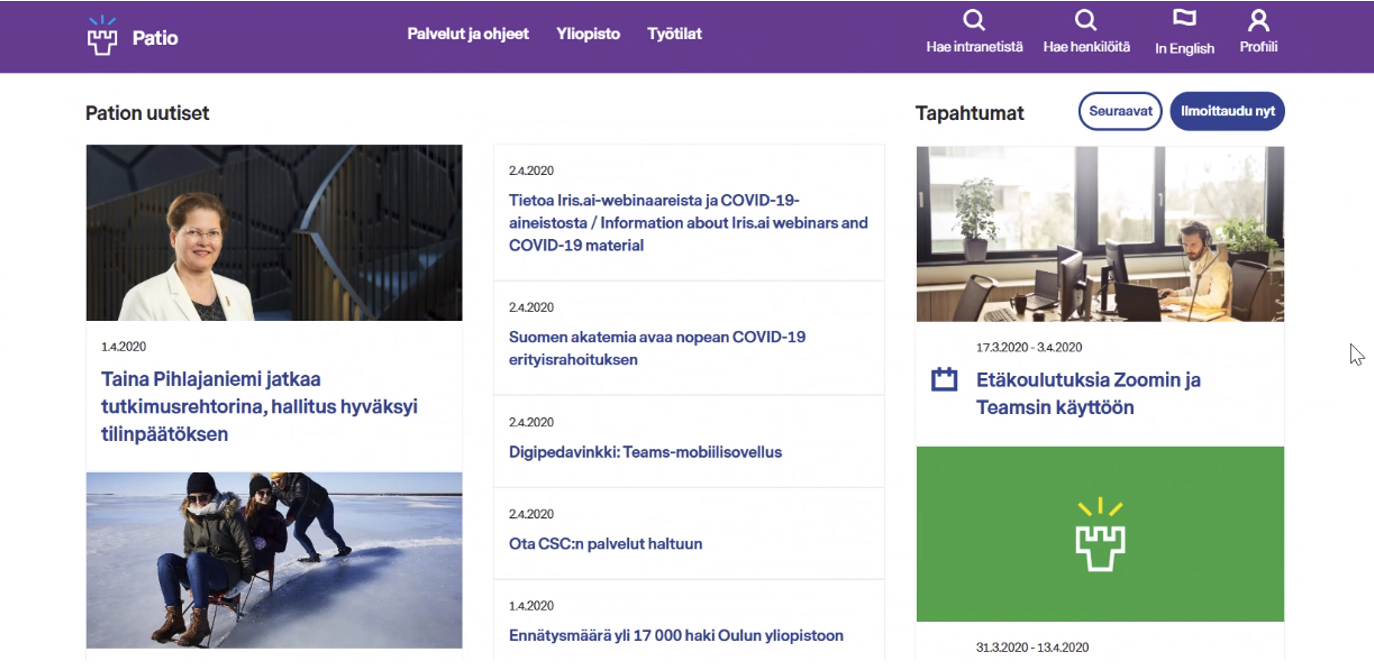The University of Oulu was tired of the fact that the staff instructions and services could not be found in the content structure of their communications intranet. The solution was to design, user test, and implement a new staff intranet with an easy-to-use service directory.
North Patrol is a consulting firm specialized in the design of digital services and information systems. We shape ideas into a vision and service concept, find the best architectural and technological solutions, design a functional user experience, and compete to find the ideal partner for implementation work. We do not sell implementation projects, nor do we sell licenses; we are genuinely on the side of the customer.

The new intranet at the University of Oulu strictly focuses on sharing factual information. Effective communication is the main aim, and nothing unnecessary is published. The staff have been very welcome to this reform, says Jaana Sandqvist, Communications Manager in charge of implementing the intranet.
The previous staff intranet was called Notio and it was implemented on the On Premises-SharePoint platform. It was not ideal for publishing and presenting communication content as a browsable website. After the university's public online service (Oulu.fi) was built on the Drupal platform, it was decided to build the intranet on Drupal, too.
In connection with the technical platform reform, the problems related to communication, discoverability, and usability of the Notio intranet were to be resolved.
Same publishing system on the intranet and the public site
By choosing the same Drupal publishing system as the platform for public and internal online services, the University of Oulu pursued the synergy benefits of running operating environments and services, as well as the learnability of content production. Common content, such as news and event information, was planned for the platforms to be presented equally on both sites.
These synergy benefits of shared content will only be redeemed later. As it was decided to implement the new staff intranet with the latest Drupal8 version, while the public Oulu.fi is still in the Drupal7 version.
When the Oulu.fi website is about to be renewed, the centralized data warehouses, used by the intranet and the public web server, can be fully taken into account in its implementation. This is made possible by the Drupal architecture.
Users took part in the design process
Planning for the reform of the Notio intranet began as early as autumn 2018. A prestudy was conducted with North Patrol on technology choices, channel roles, and the concept of communications intranet. The concept, raw user interface ideas, and requirement specifications for the staff intranet were completed at the beginning of 2019.
During the same year, the university’s Drupal partner Exove implemented the new intranet. The final user experience was refined and tested by the university’s design team.
Content producers were involved in the design of the intranet sections and page templates. The work was completed in numerous workshops and in total, more than 100 people were involved in the design work.
Feedback was collected from staff on the content and user interface plans, and a committed user panel commented on the plans at all stages. User testing was conducted using a variety of prototypes, and the final models were further tested in a pop-up round in the staff lounge.
The tests provided useful information to refine the plans and confirmed that the design work was progressing in the right direction. Employees were updated on the intranet reform by regularly informing them on intranet and divisions info sessions.
The name of the new intranet also came from the users. In a staff intranet name competition, a couple of employees suggested the name Patio to replace the old name Notio. Patio was then chosen as the name for the new staff intranet.

Patio serves its users
Among intranets focusing on communication, Patio intranet of the University of Oulu is simplified. It offers internal topical information, general division presentations, and a service directory.
The service directory is a staff guide, in which each internal service or instruction (such as a recruitment guide or sick leave or holiday accumulation) is on an easy-to-understand service page.
The service page format forces the content provider to summarize the core points of the service. Contact information for the service provider is also easy to find. If there is a business channel associated with the service, the service page gives clear instructions for the user on how to use it. The link to the business channel can always be found in the same place with the same appearance, too. Links to attachments, forms, or additional information are structured in the page template.
The service directory is a practical application that provides clear search and browsing functionality to find services. The staff of the University of Oulu can browse services by metadata categories or search for services using an open word search. In this way, the necessary, up-to-date, and correct staff instructions are always easy to find. Users appreciate this.
Simple is beautiful
The University of Oulu feels that it is swimming upstream in the trends of the current attention culture, as its intranet is a simplified tool.
The latest news and events, as well as their language versions, are easy to produce. Users can choose which division or topic they want to follow. Each user can also select tools and quick links to their Patio home page as a list of the most important applications and links for themselves.
A Patio discussion group has been created in the Office 365 environment, in Yammer. This discussion group is installed on the intranet front page as a low-threshold interaction channel.
News headlines and announcements of upcoming dissertations will be imported as an RSS feed from the public online service. Social media coverage is shared by embedding the Twitter feed.
If the staff do not have time to keep track of current daily events, Patio helps to stay up-to-date by sending out a weekly newsletter on Fridays. The newsletter automatically receives feed from news and events. In addition, a communications specialist writes it and selects the most appropriate topics for the newsletter.
The communication division at the University of Oulu was afraid to use such an “old-fashioned” communication channel but the staff have been surprisingly pleased by this form of communication. Statistics show that the newsletter is notably read and clicked on, and there have also been direct requests from staff not to discontinue the newsletter.
Often one of the goals of introducing an intranet is to reduce email floods but in this case, users want the email generated by the intranet!
For the staff, it is safe and manageable that they receive the email once a week. Hence, they do not need to be lurking for the news on the intranet and the email is strictly business. For example, for human resource management, this is a functioning information channel that reaches all staff.
App-like intranet, but surprisingly many desktop users
Patio’s most important feature is the service directory and this directory is built for optimal mobile use. Thus, the mobile views from the Patio are very simple and app-like. Special attention has been focused on search functions and data tracking to ensure smooth mobile use.
Surprisingly, however, statistics show that 98% of users use the intranet on their work desktop computers, not on mobile devices. What could be the reason for this? Are the past experiences of users so discouraging that the possibility of mobile use is not believable? Or are the university staff so strongly information workers that they only search for information in the work environment?
The University of Oulu user surveys are being used to clarify this issue. Monitoring has shown that the number of mobile users is growing little by little. It seems that the staff are slowly warming up to mobile use, which has already risen to 13% by summer 2020.
Patio has now been in use since December 2019, and further development will be carried out as a continuous line work according to the user needs.
Jaana Sandqvist, Communications Manager at the University of Oulu, who is the product owner, is responsible for the further development of the Patio. She sees the future of the Patio very bright:
“According to the June user survey, Patio was praised for its clarity and the fact that the front page offers both convenient quick links and an easy overview of current university topics. The services and instructions section is perceived to be helpful, and I am particularly pleased about this.
Further development is guided by the development needs that emerged in the user survey - some are smaller ideas from users and others are bigger development paths. The main direction for the future is the further development of the search function and the interplay between the university's various websites and related systems."
Staff intranet Patio of University of Oulu
- Customer: University of Oulu
- Technology platform: Drupal 8
- Autumn 2018 - Preliminary study and technology mapping: North Patrol
- Winter - Concept design, requirement specifications, modeling: North Patrol
- January to February 2019 – Design and modeling: University of Oulu
- November to December 2019 – Implementation: Exove
- May to December 2019 - Content work, usability testing, communication: University of Oulu
- December 2019 – Deployment
(This article has been translated from the Finnish original. Read the original article.)


